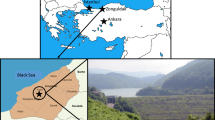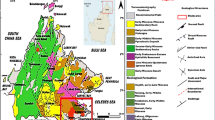Abstract
Seismic waves result from fault movement during earthquakes. Depending on the features of the physical environment through which they pass, there are variations in the velocity and amplitude of body waves, which occur underground, and surface waves, which occur on the Earth’s surface. The ratio of shear wave velocity (V s) to near-surface velocity is a parameter used widely in land use planning to predict the potential for amplified seismic shaking, especially in urban areas. The main objective of this study was to estimate V s by using cone resistance (q c) and lateral friction (f s) for a study area at Eskisehir Graben, to help mitigate geotechnical earthquake engineering problems in civil engineering and land use planning. In geotechnical shallow soil research, certain geophysical methods are used for measuring V s —a major form of seismic energy propagation—at the near surface. In this study, cone penetrometer data collected from seismic cone penetration tests (SCPT) includes q c, f s, and downhole V s. S-type seismic energy waveforms, which are produced on the surface, were measured at different depths using an S-type geophone in the city center of Eskisehir via SCPT. With SCPT, q c, friction ratios (R f), and V s values were measured at 42 different test points. R f properties are associated with soil thickness, and these were compared with dynamic soil properties (V s) using a standard statistical method; we calculated correlations amongst V s, q c, and R f measured from cone penetration tests.











Similar content being viewed by others
References
Altunel E, Barka A (1998) Neotectonic activity of Eskişehir fault zone between İnönü and Sultandere. Geol Bull Turk 41(2):41–52
Azdiken, S, Çatalyürekli E (2001) General Directoratio of State Hydraulic Works, Eskişehir Odunpazari Municipality Geophysics Resistivity Report
Barrow BL, Stokoe KE (1983) Field investigation of liquefaction sites in Northern California, Geotechnical Engineering Thesis, Civil Engineering Department, University of Texas at Austin, Austin, TX
Boore DM (2004) Estimating Vs30(or NEHRP site classes) from shallow velocity models (depths <30 m). Bull Seismol Soc Am 94(2):591–597
Brouwer J, Ghose R, Helbig K et al. (1997) The improvement of geotechnical subsurface models through the application of S-wave reflection seismic exploration. 3rd EEGS Meeting
Building Seismic Safety Council (1991) NEHRP recommended provisions for the development of seismic regulations for new buildings: Part 2: Commentary. Earthquake Hazard Reductions Series, US Federal Emergency Management Agency (FEMA), Washington, DC
Building Seismic Safety Council (1994) National earthquake hazard reduction program (NEHRP) recommended provisions for the development of seismic regulations for new buildings’. Part I, Provisions. BSSC, Washington, DC
Campanella R, Baziw E, Sully J (1989) Interpretation of seismic cone data using digital filtering techniques. Department of Civil Engineering. University of British Columbia, Vancouver
Emre Ö, Duman TY, Özalp S et al. (2013) Active fault map of Turkey with explanatory text. Special Publication Series-30, MTA (Mineral Research & Exploration General Directoratio), Ankara, Turkey
Ersoy İ (1956) Eskişehir earthquake. Arkitekt 284(2):74–75
Holzer TL, Padovani AC, Bennett MJ et al (2005) Mapping NEHRP VS30 site classes. Earthq Spectr 21(2):353–370
Hunter J, Benjumea B, Harris J et al (2002) Surface and downhole shear wave seismic methods for thick soil site investigations. Soil Dyn Earthq Eng 22(9):931–941
Larsson R (1995) The CPT test. Equipment–testing–evaluation. Swedish Geotechnical Institute, Information No. 15E
Luna R, Jadi H (2000) Determination of dynamic soil properties using geophysical methods. In: Proceedings of the First I nternational Conference on the Application of Geophysical and NDT Methodologies to Transportation Facilities and Infrastructure , St. Louis, MO, December 2000
Lunne T, Robertson P, Powell J (1997) Cone penetration testing in Geotechnical Practice. Blackie/Routledge, New York
Mayne P, Rix G (1995) Correlations between cone tip resistance and shear wave velocity in natural clay. Soils Found 35(2):107–110
Mola-Abasi H, Dikmen U, Shooshpasha I (2015) Prediction of shear-wave velocity from CPT data at Eskisehir (Turkey), using a polynomial model. Near Surf Geophys 13(2):155–167
Ocakoğlu F (2007) A re-evaluation of the Eskişehir Fault Zone as a Recent extensional structure in NW Turkey. J Asian Earth Sci 31(2):91–103
Ölmez E, Yücel B (1985) Geothermal Energy Potentiality of the near region and Eskisehir city
Ölmez E, Demirel Z, Uzel ÖF (1986) The report of deep borehole data Eskisehir ES-1 and ES 2, Report No:8142, MTA (Mineral Research & Exploration General Directoratio), Ankara, Turkey
Orhan A (2005) The geo-engineering properties of foundation soils in southern part of Eskisehir city center and applying of geographic information system (in Turkish). PhD thesis, Eskisehir Osmangazi Univertsity, Graduate School of Natural and Applied Sciences
Özmen B (2000) The damage distribution of August 1999 Izmit earthquake (numerical data). Earthquake Foundation of Turkey, TDV/DR 010-53: 132
Pekkan E, Tun M, Guney Y et al (2015) Integratiod seismic risk analysis using simple weighting method: the case of residential Eskişehir, Turkey. Nat Hazards Earth Syst Sci 15(6):1123–1133
Robertson PK, Campanella R (1984b) Guidelines for use and interpretation of the electronic cone penetration test, Soil Mechanics, Series No:69. Department of Civil Engineering. University of British Columbia, Vancouver
Robertson PK, Campanella R, Gillespie D et al (1986) Seismic CPT to measure in situ shear wave velocity. J Geotech Eng 112(8):791–803
Sevinçli T, Çatalyürekli E (2001) General Directoratio of State Hydraulic Works, Eskişehir Tepebasi Municipality Geophysics Resistivity Report
Seyitoğlu G, Ecevitoğlu GB, Kaypak B et al (2015) Determining the main strand of the Eskişehir strike-slip fault zone using subsidiary structures and seismicity: a hypothesis tested by seismic reflection studies. Turk J Earth Sci 24(1):1–20
Tün M (2003) Investigation of change in shear wave velocity (Vs) by soil properties and determination of soil natural period (T 0) in the Eskisehir Urban Area (in Turkish). Master’s Thesis, Anadolu University Graduate School of Sciences, Department of Physics
Xia J, Miller RD, Park CB et al (2002) Comparing shear-wave velocity profiles inverted from multichannel surface wave with borehole measurements. Soil Dyn Earthq Eng 22(3):181–190
Yaltırak C (2002) Tectonic evolution of the Marmara sea and its surroundings. Mar Geol 190(1):493–529
Yücel B (1986) The report of deep borehole data Eskisehir ES-3, Report No:8142, MTA (Mineral Research & Exploration General Directoratio), Ankara, Turkey
Acknowledgements
This study was supported by the Anadolu University Department of Scientific Research Projects, under project number 000401 and 1605F404. We would like to thank Associate Professor Dr. Hakan A. Nefeslioglu, A. Dagliyar, and S. Azdiken for collecting data and applying SCPT.
Author information
Authors and Affiliations
Corresponding author
Rights and permissions
About this article
Cite this article
Tun, M., Ayday, C. Investigation of correlations between shear wave velocities and CPT data: a case study at Eskisehir in Turkey. Bull Eng Geol Environ 77, 225–236 (2018). https://doi.org/10.1007/s10064-016-0987-y
Received:
Accepted:
Published:
Issue Date:
DOI: https://doi.org/10.1007/s10064-016-0987-y




